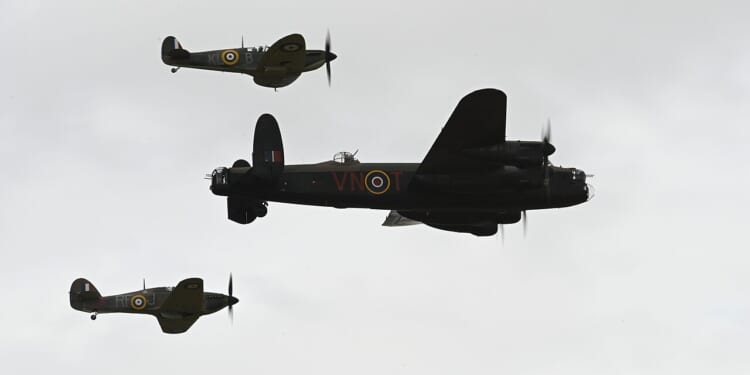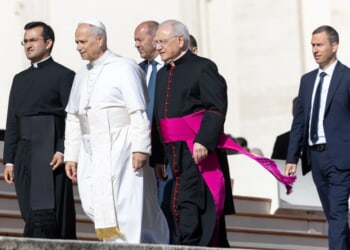The Battle of Britain ended 85 years ago today—closing a months-long air war with clear parallels to the ongoing fight in the skies over Ukraine.
Due to sugar rationing, Halloween wasn’t a significant holiday in the UK during World War II. The Halloween of 1940 likely felt particularly dismal to those on the ground at the time, as it came amid a months-long campaign of aerial bombardment on British cities. Yet October 31, 1940 marked the end of the “Battle of Britain,” Germany’s attempt to gain dominance of the skies over the United Kingdom in preparation for a ground invasion.
It was on that date that the Germans undertook the last daylight raid in the UK, before finally throwing in the towel on the concept. However, nighttime attacks on London would continue throughout the winter and spring of 1940-41—only ending when the Luftwaffe moved the bulk of its aerial might east to prepare for the invasion of the Soviet Union.
The conclusion of the Battle of Britain was gradual, even as it became apparent that Germany was changing its strategy. Yet, it is essential to note that the Blitz, which began on September 7, 1940, and continued until May 11, 1941, was likely a more terrifying phase of the war for those in London and the UK’s other cities.
The Royal Air Force Saved Britain—and the World
The end of the Battle of Britain meant that the threat of a German seaborne invasion, the planned “Operation Sea Lion,” was postponed indefinitely. The new phase of intense night bombing, when bombing raids could not be as precise but defending fighter aircraft were also less effective, was a clear indication that Germany’s attempt to destroy the Royal Air Force (RAF) had failed.
However, as the Blitz targeted cities, it resulted in approximately 43,000 civilian deaths with more than two million homes destroyed or damaged. Germany had intended to break the British morale and force a surrender. The campaign failed, instead strengthening the resolve of the British people.
With both the Battle of Britain and the Blitz, the Luftwaffe failed to gain air superiority, and it cost Germany aircraft that would have been used in combat operations against the Soviet Red Army. It also did little to damage the UK’s wartime economy. For those eight months, the nighttime bombing never seriously hampered British war production, which increased over the same period. And although the country and its people suffered tremendously, it was never plausible that the bombing would have knocked the UK out of the fight.
Ukraine Is Suffering from a Russian “Blitz”
This further serves as a reminder that Ukraine has endured what could be described as a 21st-century version of the Blitz for more than three years—and Russia has failed for many of the same reasons Germany did 85 years ago.
As The Washington Post reported earlier this year, Ukraine’s valor in holding out against Russia is comparable to the Battle of Britain. The attacks on Ukraine’s cities highlight that it isn’t the aggressor in this fight, and it has gained support across Europe and beyond. Kyiv’s will remains as unbroken as that of the UK in World War II, and Russia’s failure to achieve victory mirrors that of Germany’s Luftwaffe.
Several factors are at play, and they are not all that dissimilar to what the British faced in 1940-41. Russia employed a flawed tactical doctrine, failing to gain control of the skies early in the conflict, including suppression of enemy air defense (SEAD). Still, it also failed to integrate air power with its ground forces, resulting in a lack of close air support (CAS) and battlefield interdiction in the initial offensive operations.
Yet, whereas Germany squandered its opportunity to defeat the UK in World War II, it could be argued that, within days of the invasion, Russia was never going to secure a decisive victory.
After failing to achieve its objectives, the Russian Aerospace Forces relied on its existing doctrine, which called for defending Russian airspace rather than conducting offensive operations. Part of the issue was that Russian pilots had received significantly fewer annual flight hours compared to their NATO counterparts, and they lacked the training, as well as the muscle memory needed for the complex combat scenarios faced in the operation.
Accordingly, since the beginning of the war, the situation has tipped largely in Ukraine’s favor. Ukraine’s military has been increasingly provided with powerful and effective Western-made air defense systems, and Kyiv continues to receive NATO intelligence sharing and training. On the other side, Russia now lacks the capabilities to replace lost aircraft, whereas multiple NATO members have pledged Western fighters, including the American F-16 and the French-made Mirage 2000s.
The Ukrainian people have so far endured a war of attrition. Although Ukraine lacks the manpower that Russia can draw from, Kyiv continues to receive military hardware supplies.
That explains why Russia will continue to carry out its missile and drone strikes that are reminiscent of the Blitz and the later V1 and V2 strikes on London. Without control of the skies, Russia’s drones and missiles can only be used in a terror campaign rather than in a truly strategic fashion.
About the Author: Peter Suciu
Peter Suciu has contributed over 3,200 published pieces to more than four dozen magazines and websites over a 30-year career in journalism. He regularly writes about military hardware, firearms history, cybersecurity, politics, and international affairs. Peter is also a contributing writer for Forbes and Clearance Jobs. He is based in Michigan. You can follow him on Twitter: @PeterSuciu. You can email the author: [email protected].
Image: Wikimedia Commons.

















